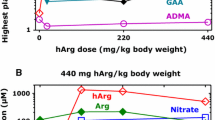Abstract
We have reported that (1) the synthesis of GSA, a uremic toxin, increases depending on the urea concentration and (2) GSA is formed from argininosuccinic acid (ASA) and the hydroxyl radical or SIN-1 which generates superoxide and NO simultaneously. However, an excess of NO, which also serves as a scavenger of the hydroxyl radical, inhibited GSA synthesis. We also reported that arginine, citrulline or ammonia plus ornithine, all of which increase arginine, inhibit GSA synthesis even in the presence of urea. To elucidate the mechanism for increased GSA synthesis by urea, we investigated the effect of urea on ASA and arginine, the immediate precursor of NO.
Isolated rat hepatocytes were incubated in 6 ml of Krebs-Henseleit bicarbonate buffer containing 3% bovine serum albumin, 10 mM sodium lactate, 10 mM ammonium chloride and with or without 36 mM of urea and 0.5 or 5 mM ornithine at 37°C for 20 min. In vivo experiments, 4 ml/100 g body weight of 1.7 M urea or 1.7 M NaCl were injected intra-peritoneally into 5 male Wistar rats. Two hours after the intra-peritoneal injection of urea or 1.7 M NaCl, blood, liver and kidney were obtained by the freeze cramp method and amino acids were determined by an amino acid analyzer (JEOL:JCL-300).
ASA in isolated hepatocytes was not detected with or without 36 mM (200 mgN/dl) urea, but the arginine level decreased from 36 to 33 nmol/g wet cells with urea. Ornithine which inhibits GSA synthesis, increased ASA markedly in a dose dependent manner and increased arginine. At 2 h after the urea injection the rat serum arginine level decreased by 42% (n = 5), and ornithine and citrulline levels increased significantly. Urea injection increased the ASA level in liver from 36–51 nmol/g liver but this was not statistically significant.
We propose that urea inhibits arginine synthesis in hepatocytes, where the arginine level is extremely low to begin with, which decreases NO production which, in turn, increases hydroxyl radical generation from superoxide and NO. This may, also, be an explanation for the reported increase in oxygen stress in renal failure.
Similar content being viewed by others
References
Bonas J, Cohen B, Natelson S: Separation and estimation of certain guanidino compounds: Application to human urine. Microchem J 7: 63-77, 1963
Horowitz HI, Stein IM, Cohen BD, White JG: Further studies on the platelet-inhibitory effect of guanidinosuccinic acid and its role in uremic bleeding. Am J Med 49: 336-345, 1970
Giovannetti G, Cioni L, Balestri OL, Biagini M: Evidence that guanidines and some related compounds cause haemolysis in chronic uremia. Clin Sci 34: 141-148, 1968
D'Hooge R, Pei YQ, Marescau B, De Deyn PP: Convulsive action and toxicity of uremic guanidino compounds: Behavioral assessment and relation to brain concentration in adult. J Neurol Sci 112: 96-105, 1992
D`Hoog R, Raes A, Lebrun P, Diltoer M, Van Bogaert PP, Manil J, Colin F, De Deyn PP: N-methyl-D-aspartate receptor activation by guanidinosuccinate but not by methylguanidine: Behavioural and electrophysiological evidence. Neuropharmacology 35: 433-440, 1996
Stein IM, Cohen BD, Kornhouser RS: Guanidinosuccinic acid in renal failure, experimental azotemia and in bone errors of the urea cycle. N Eng J Med 280: 926-930, 1969
Kopple JD, Gordon SI, Wang M, Swendseid ME: Factors affecting serum and urinary guanidinosuccinic acid level in normal and uremic subjects. J Lab Clin Med 90: 303-311, 1977
Aoyagi K, Ohba S, Narita M, Tojo S: Regulation of biosynthesis of guanidinosuccinic acid in isolated rat hepatocytes and in vivo. Kidney Int 24(supple 16): S224-S228, 1983
Aoyagi K, Nagase S, Tomida C, Takemura K, Akiyama K, Koyama A: Synthesis of guanidinosuccinate from argininosuccinate and reactive oxygen in vitro. Enzyme Prot 149: 199-204, 1996
Aoyagi K, Nagase S, Gotoh M, Akiyama K, Satoh M, Hirayama A, Koyama A: Role of reactive oxygen and argininosuccinate in guanidinosuccinate synthesis in isolated rat hepatocytes. Enzyme Prot 49: 205-211, 1996
Aoyagi K, Akiyama K, Shahrzad S, Tomida C, Hirayama A, Nagase S, Takemura K, Koyama A, Ohba S, Narita M: Formation of guanidinosuccinic acid, a stable nitric oxide mimic, from argininosuccinic acid and nitric oxide-derived free radicals. Free Radic Res 31: 59-65, 1999
Menyhart J, Grof J: Urea as a selective inhibitor of argininosuccininate lyase. Eur J Biochem 75: 405-409, 1977
Aoyagi K, Shahrzad S, Iida S, Tomida C, Hirayama A, Nagase S, Takemura K, Koyama A, Ohba S, Narita M, Cohen BD: Role of nitric oxide in the synthesis of guanidinosuccinic acid, an activator of the N-methyl-D-aspartate receptor. Kidney Int 78(suppl): S93-S96, 2001
Swendseid ME, Wang M, Vyhmeister I, Chan W, Siassi F, Tam CF, Kopple JD: Amino acid metabolism in the chronically uremic rat. Clin Nephrol 3: 240-246, 1975
Hamaguchi N, Hayashi K, Endoh H, Niki E: Dual action of nitric oxide on lipid oxidation and antioxidant. Seikagaku 68: (abstr), 1015, 1996
Kuroda M, Asaka S, Tofuku Y, Takeda R: Serum antioxidant activity in uremic patients. Nephron 413: 293-298, 1985
Aoyagi K, Nagase S, Narita M, Tojo S: Role of active oxygen on methylguanidine synthesis in isolated rat hepatocytes. Kidney Int 22(suppl): S229-S233, 1987
Nagase S, Aoyagi K, Hirayama A, Gotoh M, Ueda A, Tomoda C, Kanemaki T, Nagai Y, Kikichi H, Koyama A: Favorable effect of hemodialysis on decreased serum antioxidant activity in hemodialysis patients demonstrated by electron spin resonance. J Am Soc Nephrol 8: 1157-1163, 1997
Sogami M, Era S, Nagaoka S, Kuwata K, Kida K, Miura K, Inouye H, Suzuki E, Hayano S, Sawada S: HPLC-studies on nonmercapt-mercapt conversion of human serum albumin. Int J Pept Prot Res 25: 398-402, 1985
Author information
Authors and Affiliations
Rights and permissions
About this article
Cite this article
Aoyagi, K. Inhibition of arginine synthesis by urea: A mechanism for arginine deficiency in renal failure which leads to increased hydroxyl radical generation. Mol Cell Biochem 244, 11–15 (2003). https://doi.org/10.1023/A:1022479017087
Issue Date:
DOI: https://doi.org/10.1023/A:1022479017087




